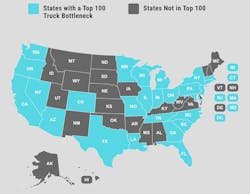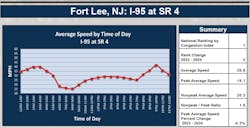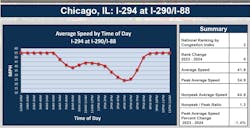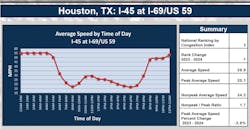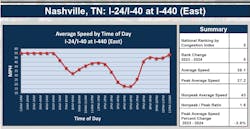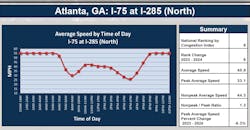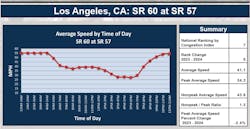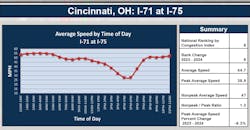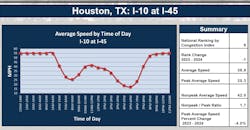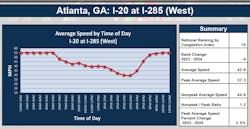ATRI's 10 worst truck bottlenecks sees a shakeup
The nation's most congested points for trucks continue to worsen, according to American Transportation Research Institute's report on the most congested truck bottlenecks. However, the work of some local policymakers appears to have paid off as one long-troublesome trucking bottleneck fell out of the top 10 this year.
1. Fort Lee, New Jersey: I-95 at SR 4
For the seventh year in a row, the nation’s top truck bottleneck is once again just outside New York City in Fort Lee, New Jersey: The intersection of Interstate 95 (Palisades Interstate Parkway) and state Route 4 has an average speed of 26 mph. At 8:00 a.m., the intersection slows to a crawling average speed of 15 mph.
2. Chicago, Illinois: I-294 at I-290/I-88
The southern portion of Illinois’s Tri-State Tollway once again ranked top 10, rising from third most impactful in 2024. Illinois is currently reconstructing much of I-294, including the infamous interchange, to provide congestion relief. The project is scheduled to be completed in 2026.
3. Houston, Texas: I-45 at I-69/US 59
During the evening, average truck speeds for this section of I-45 remain around a steady 55 mph. During daytime congestion, however, the interchange cannot accommodate traffic: Average truck speeds drop below 20 mph. Overall, the section’s average speed is 30 mph. Texas has the most congestion zones for trucking of any state, holding 12 of the top 100 bottlenecks, mostly around I-45 and I-10.
4. Atlanta, Georgia: I-285 at I-85 (North)
This section of I-285 has an average speed of 35 mph. While truck speeds are normal after midnight, daytime traffic overwhelms the area and slows speeds to below 20 mph. Georgia has the second most congestion zones among U.S. states, with nine of the top 100 bottlenecks. Nearly all of Georgia’s top bottlenecks occur near Atlanta along I-285, I-75, and I-20.
5. Nashville, Tennessee: I-24/I-40 at I-440 (East)
This section of I-24 near Nashville sees average speeds around 38 mph but has its worst traffic dip around 5:00 p.m. The afternoon rush hour regularly slows trucks below 20 mph. Tennessee’s sections of I-24 and I-40 appear in ATRI’s top 100 bottlenecks seven times.
6. Atlanta, Georgia: I-75 at I-285 (North)
This section of I-75, the second-worst bottleneck near Atalanta, is less extreme than the top five congestion zones. The average truck speed near this interchange is 41 mph. While speeds suffer during morning and afternoon congestion, trucks’ slowest average speed remains above 25 mph.
7. Los Angeles, California: SR 60 at SR 57
This section is the worst interchange between two state routes. Average truck speeds suffer most in the afternoon rush hour, slowing below 30 mph. California has eight of the top 100 bottlenecks, with most congestion occurring around Los Angeles.
8. Cincinnati, Ohio: I-71 at I-75
Truck speeds for this section of I-71 average 45 mph, suffering most congestion in the afternoon. Around 4:00 p.m., trucks often slow down below 30 mph.
9. Houston, Texas: I-10 at I-45
This section of I-10 is another I-45 interchange in the Houston area to suffer from severe congestion. Trucks average 37 mph, slowing to 25 mph in the morning rush and below 20 mph in the afternoon rush.
10. Atlanta, Georgia: I-20 at I-285 (West)
The tenth worst bottleneck for truck freight again goes to an Atlanta-area interchange. This section of I-20 fosters an average truck speed of 43 mph, suffering most congestion around 5:00 p.m. as trucks slow to around 30 mph.
